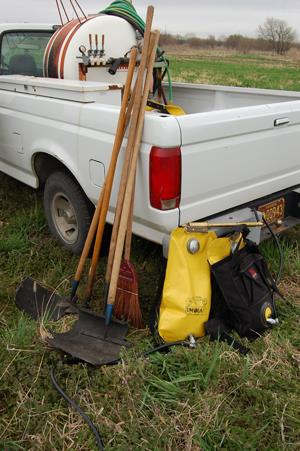Educational Resources
Smoke Management
 All rangeland fires produce smoke which can be detrimental to air quality for thousands of people as smoke is carried away from the burned area. Fire Management Practices (FMPs) attempt to reduce the negative effects of smoke that impact air quality, visibility, health, and safety. FMPs reduce smoke-related air quality problems in three ways: by avoiding smoke movement into sensitive areas; diluting smoke concentrations through management and planning; and reducing the total amount of smoke produced.
All rangeland fires produce smoke which can be detrimental to air quality for thousands of people as smoke is carried away from the burned area. Fire Management Practices (FMPs) attempt to reduce the negative effects of smoke that impact air quality, visibility, health, and safety. FMPs reduce smoke-related air quality problems in three ways: by avoiding smoke movement into sensitive areas; diluting smoke concentrations through management and planning; and reducing the total amount of smoke produced.
- Smoke Management Impacts and Smoke Management Practices (PDF)
- Fire Management Practices for Air Quality Attainment (PDF)
- Fire Management Practices Check List (PDF)
- Fire Management Practices Pamphlet - KDHE (PDF)
- Basic Smoke Management Practices (PDF)
- Air Quality Concerns of Prescribed Range Burning in Kansas (PDF)
- Smoke Management Guidebook for Prescribed Burning in the Southern Region
- Smoke 101 and the Differences Between Wildfire and Prescribed Fire Smoke in the Western U.S.
- Additional Resources
- Great Plains Fire Science Exchange
- K-State Research and Education County/District Offices
- Kansas Prescribed Fire Council
- Kansas Prescribed Fire Contractors
- Kansas Forest Service Wildfire Prevention/FireWise Communities
- Oklahoma State University Fire Ecology
- Smoke Management and Air Quality Training
- EV Komack Fire Ecology Database
- EPA Agricultural Burning
- EPA Agricultural Air Quality Conservation Measures Reference Guide
- Prescribed Fire Lessons Learned
Smoke Modeling
Prescribed Burning
A prescribed burn is conducted to meet specific management objectives. Native Americans are thought to have used fire on what are now Kansas grasslands for the past millenia for some of the same reasons rancher use fire today, such as providing high quality forage for food animals and reducing woody plant encroachment into grasslands.
- Benefits of Rangeland Burning (PDF)
- Relative Benefits of Prescribed Burning to Wildfire (PDF)
- Kansas Open Burning Regulations (PDF)
- Prescribed burn plan (PDF)
Reasons for burning
Prescribed burns can have one or more objectives. Not all objectives can be met with the same burn regimen, but often a single burn can accomplish multiple objectives. Prescribed burning objectives could be the following:
- Increase desirable vegetation
- Decrease undesirable vegetation
- Improve grazing distribution
- Enhance livestock performance
- Improve plant vigor: litter and thatch removal
- Manipulate wildlife habitat
- Maintain prairie ecosystem
- Reduce wildfire severity
- Comply with CRP contract requirements
- Prepare seedbed
- Prescribed Burning as a Management Practice